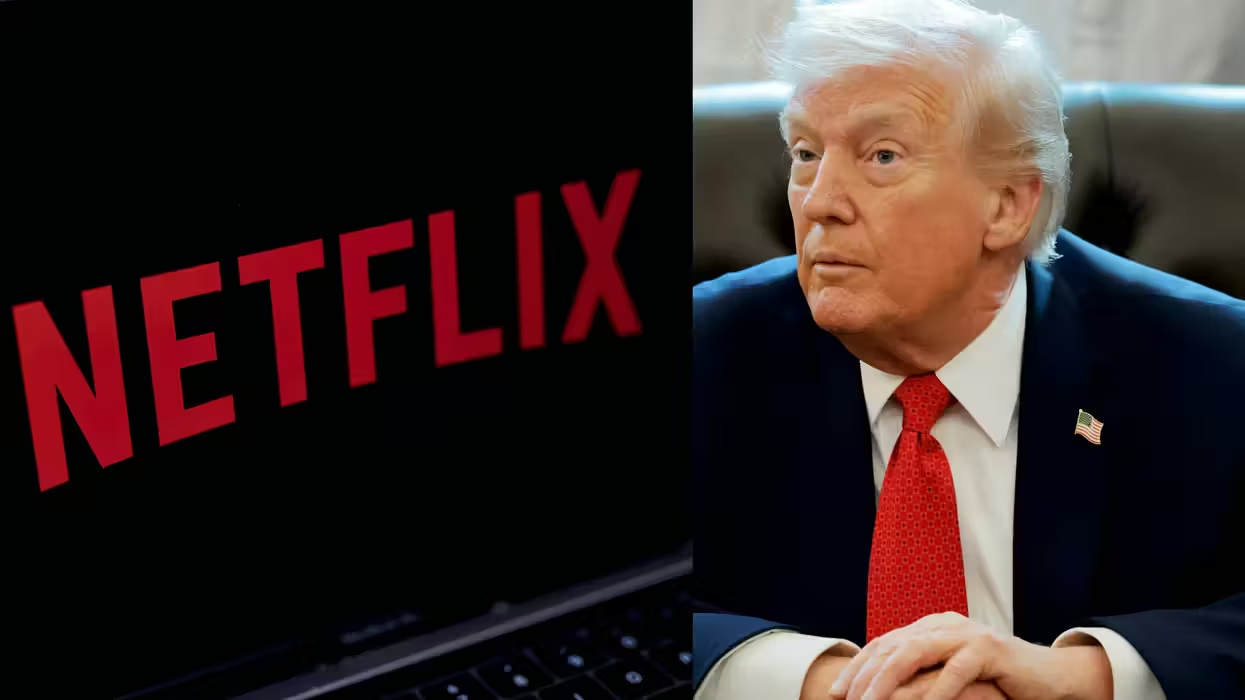
© 2025 Blaze Media LLC. All rights reserved.
First-Ever Video of Rev. Wright's 'Audacity to Hope' Sermon Extolling Malcolm X & Condemning Chicago as City That 'Hates Blacks' -- the Homily Obama Said Brought Him to Christ
November 04, 2012
"...a race despised because of its color..."
- This is first video to be released, to TheBlaze's knowledge, of the Rev. Jeremiah Wright's "Audacity to Hope" sermon
- Delivered numerous times with varying degrees of political imagery, this is the homily (at least a version of it) that President Barack Obama claims brought him to Christianity
- In the sermon, Wright accuses Chicago of being a city that "hates blacks," while seemingly praising Malcolm X in front of a mostly-white audience
- Other versions of the speech range from apolitical to overtly controversial in their inclusion of racial and political themes
 Rev. Jeremiah Wright during his "The Audacity of Hope" sermon in 1990 (Photo Credit: FILE)
Rev. Jeremiah Wright during his "The Audacity of Hope" sermon in 1990 (Photo Credit: FILE)
Freelance writer Charles C. Johnson contributed to this report.
It's widely known that President Barack Obama's book, "The Audacity of Hope" was named after a sermon that has been delivered numerous times by his former pastor, the Rev. Jeremiah Wright. TheBlaze has secured footage from the fascinating homily -- an address that, in many ways, has shaped the president's faith, worldview and career (Obama claims he responded to an altar call and became a Christian after first hearing the sermon in 1988).
Before explaining the contents of Wright's speech, it's important to highlight a few facts. To begin, this is the first time, to TheBlaze's knowledge, that a video version of "Audacity to Hope" has been released. While the video presented within this article is not the same sermon that led Obama to the Christian faith, it is one of the many scripted deliveries of the controversial pastor's message (and is likely similar in content, though potentially toned down, to what Obama first heard). While it is not clear when and where this version of "Audacity to Hope" was delivered, the clip comes from Eden Theological Seminary in Saint Louis, Missouri.
WRIGHT'S "AUDACITY TO HOPE" VIDEO SERMON: AN OVERVIEW
Contrary to his past sermons that have gained media attention, this version of Wright's "The Audacity to Hope" is calm in nature and appears, on the surface, to embrace universal ideals that apply to most Christian adherents. While there are some racial themes, they are isolated, toned down and much less pronounced than one might expect (however, other versions of the speech are more fiery, as we will explore).
Wright opened the sermon (circa 1990) by discussing a trip to Richmond, Virginia, he took several years before. He recalled hearing another preacher, the Rev. Frederick G. Sampson, speak about a painting that Wright was familiar with. The piece of artwork, by artist George Frederic Watts, entitled, "Hope," features a woman playing the harp and sitting on top of the world, and it is one of the centerpieces of Wright's 1990 address.
"The world on which this woman sits -- our world -- that world is torn by war, destroyed by hate, decimated by despair and devastated by mistrust," Wright told his audience.
 George Frederic Watts' "Hope" (Photo Credit: FILE)
George Frederic Watts' "Hope" (Photo Credit: FILE)
The faith leader goes on to explain that, while the image looks harmonious on the surface, the woman is, in fact, sitting on a world that is on the "brink of destruction," with famines ravishing "millions of black and brown inhabitants." Wright also proclaimed that the painting depicts a world with "enough nuclear warheads to wipe out all forms of life except for cockroaches."
Clearly, Wright was making a statement about how the piece of art, which depicts suffering in the world, can be applied with today's inequality-filled global schema. This is perhaps best encapsulated in another statement he made that the situation depicted in "Hope" is one "which is more concerned with the color of skin than it is with the content of character."
The reverend further highlighted the painting's overall theme -- that, while situations and peoples' lives may sometimes look positive, when digging behind the surface, potentially-ugly realities may emerge.
"We give the allusion of being in an enviable position, but when you look closer at our lives, what you begin to find is the reality of a pain almost too deep for the tongue to tell," Wright proclaimed. "Lots of things that look good on the outside don't look good on the inside, like the woman in Watts' painting."
At the center of the sermon is 1 Samuel 1-18, which Wright spent a great deal of time focusing upon. In the story, Hannah was one of two wives to Elkanah and, according to the Bible, she dealt with some serious challenges (among them, she was barren).
"What looked like power and illusion, was in reality pain," Wright said of Hannah's life.
Watch this portion of the sermon, below:
Wright went on to speak about Hannah's personal hell, subsequently relating these challenges to the problems that those in his audience likely face in their own lives.
"While I'm talking about Hannah, I want you to be thinking about that private hell in which you live," he told a mostly-white audience. "You know what it is. I don't have to call the role. You live there."
Watch these comments, below:
Throughout the speech, the terms "audacity," "hope" and "audacity of hope" were prevalent (the transcript of a separate version of the address, while somewhat different, can be read here). While heralding Hannah who continued to pray, despite not getting the answers she was hoping for (she appealed to God for a child), Wright encouraged those in attendance to have the same perseverance. Here's a transcript of one of the more powerful portions of the address:
"We glory in tribulation, because tribulation works patience and patience works experience and experience works hope -- the vertical dimension -- and hope makes us not ashamed. The vertical dimension balances out what is going on in the horizontal dimension. That is the real story here in 1 Samuel 1 -- not the condition of Hannah's body, but the condition of Hannah's soul -- the vertical dimension. She had the audacity to keep on hoping and keep on praying -- and keep on praying when there was no physical sign on the horizontal level that that that which she was praying and hoping would ever be answered in the affirmative. That which she wanted most in life had been denied to her."
Wright made a designation between "horizontal" and "vertical." The pastor explained that the former is the physical dimension, with the latter serving as the spiritual. Despite praying without ceasing, Hannah didn't give up and continued appealing to God. According to the Bible, she eventually gave birth to Samuel and her prayerful appeals to the Lord paid off. The preacher related the story of hope and continued faith to those in the audience.
"There may not be any physical sign of a change in your individual situation whatever your private hell is, but that's just the horizontal level," Wright said. "Check out the vertical level like Hannah and you may, as the African slaves, be able to sing."
He implored the audience to "have the audacity to hope" for children, husbands, homes, schools and other areas of life in which congregants may be suffering. The controversial preacher also told those listening to "keep on hoping, keep on praying, keep on waiting," as he remained calm throughout the majority of the address.
RACIAL CONTENT IN WRIGHT'S VIDEO HOMILY
While race was certainly not the focus of the speech in this video version, Wright did make some controversial comments toward the end of the sermon. Here's a transcript of these claims -- statements that seem out-of-step with the remainder of the homily:
"In order for some ex-slaves to turn defeat into victory to turn devastation into liberation, to turn nothing into something...somebody had the audacity to hope. In order for a race despised because of its color to turn out a Martin King and a Malcolm X, a Paula Giddings and Paule Marshall, a James Baldwin and a Toni Morrison...[and]...another preacher named Jesus, somebody had the audacity to hope. In order for a poor black boy from the south side of Chicago to rise from the ghetto, go to college, graduate from law school and become the first black mayor in a city that hated and still hates blacks -- in order for a Harold Washington -- somebody had the audacity to hope."
Watch the last segment of Wright's speech below (the aforementioned portion starts at 3:40):
While, to TheBlaze's knowledge, this is the first video version of the speech to be released to date, some audio versions have been floating around the internet for quite some time. The most cited version of the address, which follows an almost identical structure but lacks most of the racial elements, was published by Preaching Today, a resource of Christianity Today.
Many have pointed to this audio selection to claim that Wright is moderate and to defend him against critics who have decried his more controversial sermons. Preaching Today originally published the speech in 1990; in 2010, the web site, again, posted Wright's words, with a caveat.
An editor's note before the text acknowledges that the company was aware of the speech's controversial nature. It reads, "Editor's note: In light of current political controversy, questions have been raised about the following sermon by Jeremiah Wright. Preaching Today published this sermon in 1990."
THE "AUDACITY TO HOPE" AUDIO SERMON: AN OVERVIEW
At the beginning of the audio file, which was posted on YouTube by someone outside of the Christianity Today realm (it appears to only be available in its official form to members of the Christian web portal) an introduction to Wright's sermon claims that the pastor originally prepared "Audacity to Hope" for the Chicago Sunday Evening Club. Listen to part one, below:
And here's part two:
So, there you have it -- a video version and an audio version of "The Audacity to Hope" (two slightly different variations). As TheBlaze has previously highlighted, Obama has noted the importance of this sermon in his own life -- and career -- before.
OBAMA'S CONNECTION TO WRIGHT'S CONTROVERSIAL SERMON
“I’m not plugging the book, but the title of it, ‘The Audacity of Hope.’ Some people have noticed that I actually used that line in the speech that I gave at the 2004 Democratic Convention,” Obama told a Pennsylvania crowd at a political event in November 2006. “But I tell you what: I’m confessing to all of you here today — it’s a big crowd, 2,000 people — I’m confessing in front of the TV cameras: I actually stole this line from my pastor, Dr. Jeremiah A. Wright, Jr.”
It's clear that the two, aforementioned versions of the speech were not the only ones that Wright delivered (remember: Obama claims to have heard the sermon in 1988 as well). Back in 2008, National Review's Stanley Kurtz explained that there may actually be at least three, separate "Audacity" speeches. At the time, he wrote about another, more political version of the homily:
It seems clear that the sermon text posted by PreachingToday.com and reposted on many blogs during the height of the Wright controversy in March is not, in fact, a complete text of what Obama heard on that fateful day. A longer and decidedly more political text, can be found in What Makes You So Strong? Sermons of Joy and Strength From Jeremiah A. Wright Jr. The “Audacity to Hope” sermon reprinted in that volume may not be precisely what Obama himself first heard, but it does seem significantly closer to the original than the text posted last month at PreachingToday.com.In any case, the book version of the famous “Audacity” sermon, like the other sermons reprinted in What Makes You So Strong? provides a fascinating window into Reverend Wright’s political and social worldview. Out of this collection come passages equating Zionism with racism, offering criticism of the Catholic practice of Holy Communion, defending Louis Farrakhan, and attacking American military interventions in Panama, Grenada, and the first Gulf War. [...]
It’s difficult to draw firm conclusions about the relationship between the “Audacity of Hope” sermon described in Obama’s book, Dreams from My Father, the sermon-text posted on PreachingToday.com, and the text printed in What Makes You So Strong? The sermon described in Obama’s book appears to have been delivered sometime in the late winter or spring of 1988. The text posted at PreachingToday.com dates from 1990, and the version in What Makes You So Strong? was delivered in early 1991.
Kurtz explained that, based on his analysis, "What Makes You So Strong?" description is most likely more similar to what Obama heard -- at least based on the president's analysis of the speech in his book. Here's a portion from the "What Makes You So Strong" ("Audacity to Hope") version of the sermon (as collected by Kurtz):
In order for a people to have taken a negative and turned it into a positive, surely somebody had to have had the audacity to hope. In order for a race held in bondage to slavery to have taken a proclamation not worth the paper it was written on and to have turned it into a proposition that produced a race full of giants, somebody had to have had the audacity to hope. Abraham Lincoln is remembered as the “Great Emancipator” of the slaves, but in reality, he did not see black Africans as equal with whites. (The issue of slavery was paramount for him because it threatened the unity of the country. The primary reason that the Civil War was fought was not to free the slaves, but to save the United States…. [p. 104]) [...]It was all right for this preacher [MLK] to protest against North American apartheid and segregated lunch counters, but when he dared speak the message God gave him against our racist, militaristic posture in South Vietnam and our racist involvement in South Africa, he was iced and isolated by all the establishment blacks. And in order for him to hang in and hold on, in order for him to have the audacity to hope, he had to have a vertical hookup that assimilated Negroes had forgotten all about. It was a hookup that said “before I’d be a slave [a slave to conservative theology that enslaves and preaches love], before I’d be a slave [a slave to right-wing ignorance that wears black robes on Sunday morning and white robes on Sunday night], before I’d be a slave [a slave to white America’s corporate dollars that hold and pull the purse strings of so many national black organizations], before I’d be a slave, I’d be buried in my grave, and go home to my God and be free.”….Martin was a man who integrated the buses of Montgomery and the streets of Selma, yes, but Martin also took on the unjust economic system of our country. He took on the iron-fisted military system….
[N.B.: The brackets in this passage were inserted by Wright himself, as a way of updating the meaning of an old anti-slavery spiritual. Also, “vertical hookup” here means “connection to God.” (p. 105)]
Kurtz notes that discerning between the three versions of the speech is difficult, but that the lack of political messaging in the Preaching Today selection does cause one to pause and wonder if it was, indeed, tamed down (or if it is purposefully being floated in an effort to make Wright look more moderate).
Of course, the preacher was also addressing a mostly-white audience in the video version of the speech we presented -- a factor that may have impacted the lack of racial content in the Preaching Today audio version of the speech as well (however, we do not know much about the audience in this latter selection).
In the end, the address provides further background on one of the influencing factors that helped to shape Obama's faith and worldview.
Editor's note: TheBlaze Editor-in-Chief Scott Baker discussed this story with writer Billy Hallowell during Sunday's live BlazeCast -- here is the archived version of that discussion:
TheBlaze would like to credit Gateway Pundit, as he was an invaluable resource in obtaining the video version of "Audacity to Hope."
--
Related:
Want to leave a tip?
We answer to you. Help keep our content free of advertisers and big tech censorship by leaving a tip today.
Want to join the conversation?
Already a subscriber?
Billy Hallowell is a digital TV host and interviewer for Faithwire and CBN News and the co-host of CBN’s "Quick Start Podcast."
Billy Hallowell
Billy Hallowell is a digital TV host and interviewer for Faithwire and CBN News and the co-host of CBN’s "Quick Start Podcast."
more stories
Sign up for the Blaze newsletter
By signing up, you agree to our Privacy Policy and Terms of Use, and agree to receive content that may sometimes include advertisements. You may opt out at any time.
Related Content
© 2025 Blaze Media LLC. All rights reserved.
Get the stories that matter most delivered directly to your inbox.
By signing up, you agree to our Privacy Policy and Terms of Use, and agree to receive content that may sometimes include advertisements. You may opt out at any time.






